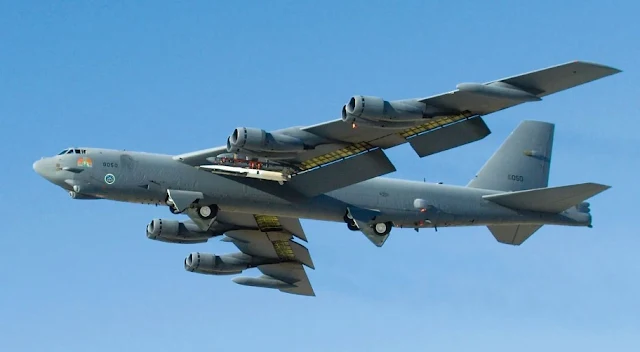 |
| B-52 Bomber Will Increase Service To 100 Years |
International Military - The United States Air Force has made a breakthrough with plans to extend service to the B-52 Stratofortress long-range strategic bomber. The old fleet of the US Air Force is planned to remain in the air until 2052. At the same time, the B-52 bombers are upgraded with several new technologies such as AESA radar to Rolls-Royce F130 engines.
Boeing has released a video showing that the B-52 Commercial Engine Replacement Program has completed wind tunnel testing for the installation and use of the aircraft's new Rolls-Royce F130 engine, according to an article by The War Zone published on Tuesday. The video was posted to Boeing's official Twitter account and stars a 4 percent scale model of the B-52.
The model is located in Boeing's transonic wind tunnel, where it was recorded to have undergone testing at a maximum speed of Mach 0.92 and helped collect data for future flight trials. Four engine pods can be seen which will soon be home to eight Rolls-Royce F130 engines.
 |
| Bomber B-52 Will Be Equipped With Rolls-Royce F130 Engine And EASA Radar |
In the video, Mike Seltman, an aerodynamics engineer at Boeing, further claims that the F130 engine will be more fuel efficient and maintenance friendly than the Pratt & Whitney TF33-PW-103 currently used by the B-52.
This ancient and outdated machine has been out of production since 1985 and will soon be out of support after 2030 as it becomes too expensive to maintain.
The new contract states that each F130 to be delivered will account for a one-for-one replacement of the eight TF33 engines currently in each of the Air Force's 76 B-52s. It is also estimated that spare parts will be provided.
Meanwhile, Rolls-Royce claims that the new engine will achieve 30% greater fuel efficiency, increased range, better field performance, improved reliability and reduced tanker aircraft requirements. This remains to be verified as specific performance metrics for the F130 have not yet been released.
Rolls-Royce further claims that the F130 has been engineered to be able to remain 'on the wing' throughout the planned duration of the B-52's life. The plane will also go through various upgrades in the near future, and it's unclear how those upgrades will affect its engines.
For now, however, it seems that everything is going smoothly, and the B-52 is expected to fly with new and improved engines in the near future.
Read Also: Equipped with AESA Radar to Rolls-Royce F130, B-52 Bomber Planned To Operate Until 2052
The U.S. Air Force plans to upgrade the B-52 into service with Uncle Sam until 2052. If it were to be in service until 2052 as planned, then the B-52 bomber would be 100 years old since it first entered service with the U.S. Air Force in 1952.
And if the B-52 manages to extend its lifespan to 2052, it will be the first aircraft in continuous service for 100 years. Even attempts to extend the life of the main bomber have been proposed recently.
"The B-52 has been and will continue to be a component of the nuclear triad," said a statement from the United States Air Force Global Strike Command, which is responsible for defining long-range and strategic bombing operations.
Speaking to the international defense website, Boeing Bombor Program Senior Director Jennifer Wong said the US Air Force plans to keep the B-52 in service through several capability upgrades. Among the upgrades include engine replacement, modernization of the aircraft's radar system and high-frequency satellites.
Recently, it was confirmed that the B-52 bomber will be equipped with the same AESA radar as that used by the F/A-18E/F Super Hornet, the Raytheon AN/APG-79.
The AESA radar will give the B-52 aircraft greater capability to detect ground targets, target detectors, range and more. The eight engines of the B-52 will also be replaced from the aging Pratt & Whitney TF33 engine with the Rolls-Royce F130 engine variant.
The B-52 aircraft will also have a new communication system when using IRIS which is a Beyond-Line-Of-Sight Communication System (BLOS) to replace the Global Iridium Bomber Set System (GLIBS) which has been operating since 2017.
Originally designed as a high-speed bomber, the B-52 currently has the capability to carry and launch the AGM-86B Air-Launched Cruise Missile (ALCM).
The B-52 is the primary strategic nuclear and conventional weapons platform for the United States Air Force. Currently 70 years old, the B-52 is in widespread use by the United States Air Force although the air force has other strategic bombers such as the B-1 Lancer and B-2 Spirit. At this point the United States deployed the B-52s to the Swedish and Finnish borders.
The United States also deployed B-52 aircraft on the Bomber Duty Mission to the Indo-Pacific. The US still has about 58 B-52 strategic bombers in service with the United States Air Force today, with 18 in reserve and 12 in storage. In total, they have built 744 B-52 strategic bombers for its use.
